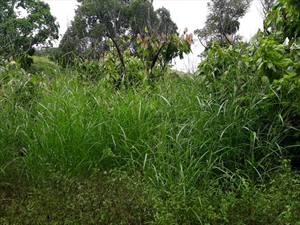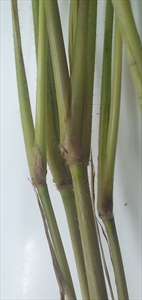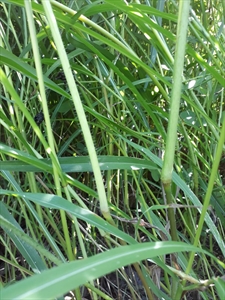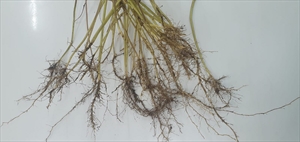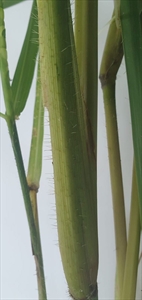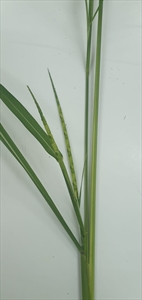Itch grass
Pacific Pests, Pathogens, Weeds & Pesticides - Online edition
Pacific Pests, Pathogens, Weeds & Pesticides
Itch grass (458)
Rottboellia cochinchinensis; it was known previously as Rottboellia exaltata. It is a member of the Poaceae.
Asia, Africa, North, South and Central America, the Caribbean, Oceania. It is recorded from Australia, Fiji, Papua New Guinea, and Solomon Islands.
It is thought to be native to Vietnam; it is now found throughout the world.
An aggressive, invasive grass of the tropics and sub-tropics that colonises open, well-drained sites, but also found in wet places, even in shallow water (Photo 1). It readily invades disturbed sites along roads and railways. Commonly, between 800-1300 masl. Each plant produces many thousands of seeds (2000-16000 recorded in the Philippines) which helps to account for the invasiveness of itch grass, combined with an ability to thrive under a range of environmental conditions. It is also difficult to control.
Itch grass has cylindrical, hollow stems, branching at the upper nodes (swollen areas on the stems where leaves arise) (Photo 2). The leaves are blue-green when growing vigorously, otherwise yellowish, flat, 5-20 mm wide with conspicuous pale mid-vein (Photo 3). There are prop roots at the base of the stems, and plants produce multiple tillers (Photos 4&5). Hairs of silica are present on the leaf sheath that can penetrate and irritate the skin (Photo 6). Flowers are borne on a spike up to 15 cm long; the spikes can be on their own or in groups of 3-4, arising from the leaf axils at the top of the stem (Photos 7&8). As the spikes mature, the cylindrical rice-size seeds progressively break free starting from the furthest end and fall to the ground (Photo 9).
Spread is by seeds carried by birds, flood water, rodents, and farm machinery. Long distance spread is along transport routes, and as a contaminant of rice seed.
Itch grass is considered a serious problem in soybean, corn, cotton, peanut, upland rice, and sugarcane. There are documented cases from Africa, South America, and Southeast Asia of the threat of this weed in these crops. There are estimates of losses in sugarcane of between 20-70% in Argentina, Cuba, India, Mauritius, Trinidad, and the USA. In Costa Rica, control costs in maize may amount to a quarter of the income from selling the grain.
The weed is also an alternative host for virus diseases that affect maize in several countries. In Pacific islands, it is a host of Maize mosaic nucleorhabdovirus (see Fact Sheet no. 074).
Additionally, the hairs on the leaf sheaths can cause painful skin infections to those working in crops where the grass is present.
Not considered useful, even as a fodder grass.
BIOSECURITY
There is a high risk of introducing this weed. Countries not yet infested should consider all likely pathways for entry, and apply quarantine measures accordingly. Particular attention should be given to the risks associated with the weed as a contaminant of legume, rice and other seeds. The use of certified seed is important.
It is listed as a noxious weed in the USA - prohibited plants that must be controlled - they serve no economic purpose and possess characteristics that are harmful to humans, animals or the environment. The Global Invasive Species Database (2020) says that Rottboellia cochinchinensis is one of the 12 worst weeds of sugarcane, and a competitive weed of maize.
BIOLOGICAL CONTROL
No commercial products are available; however, there are several fungi with potential as mycoherbicides, for instance: a rust, Puccinia rottboelliae; a smut, Sporisorium ophiuri; and species of Colletotrichum and Exserohilum.
CULTURAL CONTROL
It is important to prevent plants from setting seed. Large numbers of seed are produced that remain viable in the soil for 3-5 years.
- Physical & Mechanical
- Hand weed. Costly, as it has to be done frequently; within the row weeding is used for maize, in addition to mechanical cultivation.
- Slashing. This is often used on small farms between crops rows, but, if infestations remain within the row, the potential for yield loss remains as well as a build-up of seed in the soil.
- Mechanical cultivation. Shallow tillage is useful with the aim of promoting seed germination before planting. Usually, this has to be done more than once before planting, and then again during crop growth. Often, herbicide is needed after tillage as it may result in extremely high densities of seedlings.
- Hygiene
- Treat vehicles and farm machinery. Wash down vehicles first before moving from areas where the weed occurs to those weed-free. Wash to remove soil and seed. Also, ensure seeds are not carried on clothes between infested and 'clean' areas.
- Plant cover crops
- Either use as part of a rotation or as intercrops. Mucuna (velvetbean) has been an appropriate choice in many locations, but there are many other legumes that can be used. Seek local expertise on suitable choices.
- Interplanting
- Interplanting a food legume with maize is a common method in many locations. There is still a need to deal with the grass within the row.
- IPM
- Use a combination of fire, ploughing and fallow. Burn the land to destroy seed, plough to stimulate germination, deep plough to bury the seedling, and then leave fallow to check that buried seed is dead and that the land is clear of itch grass. A managed fallow using a legume cover crop is also a possibility.
CHEMICAL CONTROL
In Australia, the following is registered for the control of itch grass: hexazinone + diuron. In Fiji, glyphosate; diuron.
--------------------
Note, hexazinone is not approved for use in the EU.
____________________
When using a pesticide, always wear protective clothing and follow the instructions on the product label, such as dosage, timing of application, and pre-harvest interval. Recommendations will vary with the crop and system of cultivation. Expert advice on the most appropriate herbicides to use should always be sought from local agricultural authorities.
AUTHORS Grahame Jackson, Aradhana Deesh & Mani Mua
Information from CABI (2019) Rottboellia cochinchinensis (itch grass). Invasive Species Compendium. (https://www.cabi.org/isc/datasheet/47782); and Itchgrass Rottboellia cochinchinensis (2014) Texas Invasive Species Institute.(http://www.tsusinvasives.org/home/database/rottboellia-cochinchinensis); and from Global Invasive Species Database (2020) Species profile: Rottboellia cochinchinensis. (http://www.iucngisd.org/gisd/species.php?sc=772). Photo 9 Steve Hurst, USDA NRCS PLANTS Database, Bugwood.org.
Produced with support from the Australian Centre for International Agricultural Research under project HORT/2016/185: Responding to emerging pest and disease threats to horticulture in the Pacific islands, implemented by the University of Queensland, in association with the Pacific Community and Koronivia Research Station, Ministry of Agriculture, Fiji.
